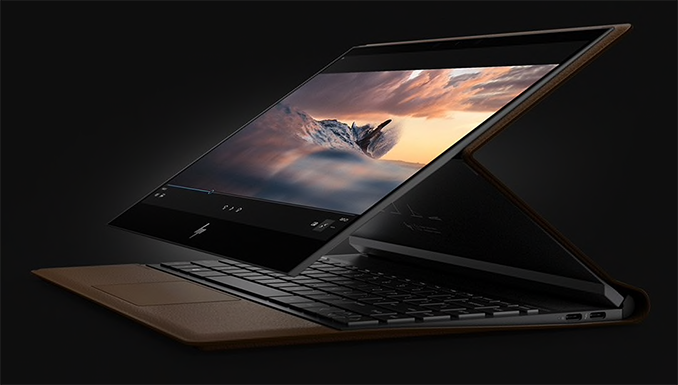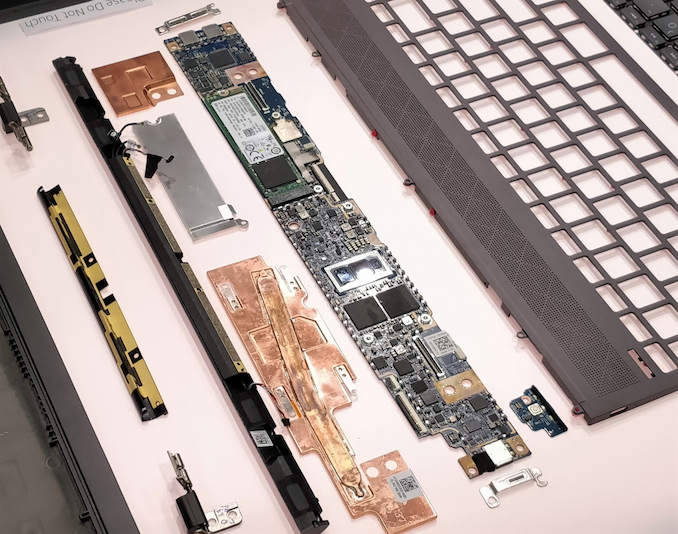Intel's Customized SoC for HP: Amber Lake-Y with On-Package LTE Modem
by Anton Shilov on October 4, 2018 11:00 AM EST
Announced earlier this week, HP’s Spectre Folio convertible notebook already looks remarkable due to its leather exterior. As it appears, the system is as impressive inside as it is on the outside, as it incorporates a custom Intel’s Amber Lake-Y multi-chip-module that features an LTE modem.
According to a report from PC World, the internal design of the Spectre Folio PC convertible notebook was co-developed by HP and Intel engineers under Intel’s Innovation Excellence Program, which is aimed at enabling PC makers to bring state-of-the-art designs to the market. The product uses a tiny, jointly-designed motherboard that measures only 12,000 mm2 and is based around a unique multi-chip module that carries Intel’s Amber Lake-Y SoC, a PCH (platform controller hub), and Intel’s Intel XMM 7560 LTE Advanced Pro Cat16/Cat 13 modem.

Image via PC World
Intel/HP did not disclose how integration of a modem affected the TDP of the whole MCM, but it was implied that hot components were intelligently installed in such a way that they would not affect each other and cause performance throttling. Furthermore, the two companies also said that the collaboration helped to shrink the motherboard area from 15,000 mm2 to 12,000 mm2, which normally allows for a bigger battery.

Image via PC World
Intel is not new to selling complete platforms comprised of a CPU, a chipset, and a communication module. Back in 2000s the company made a fortune selling its Centrino-branded sets containing the aforementioned elements. By selling multiple chips at once, Intel naturally increases its revenue, whereas system vendors ensure compatibility. Therefore, platform-level integration is a win-win for all parties. With that said, this is the first time we've seen Intel put a CPU, a PCH, and a cellular modem onto one multi-chip-module in this fashion. So this may be the start of a trend for the company.
Earlier this year the chipmaker also introduced its Kaby Lake-G processor, which featured an on-package custom Radeon RX Vega M GPU and 4 GB of HBM2 cache and was designed for laptops that require high-performance discrete graphics. Addressing specialized systems with custom MCMs is a good way to ensure sales of its own components and enable development of PCs that would otherwise might never materialize.

Image via PC World
Related Reading:
- HP Announces The Spectre Folio: Leather Laptop
- Acer’s Swift 3 Laptop Gets 13.3-Inch Display, Slimmer Chassis, LTE Modem
- HP Unveils Spectre: The World’s Thinnest Laptop
- HP at CES 2018: HP Spectre x360 using Intel with Radeon RX Vega M, $1370
Source: PC World










13 Comments
View All Comments
repoman27 - Thursday, October 4, 2018 - link
While that board does look rather dense, and the Spectre Folio looks quite interesting in general, 12,000 mm^2 is still pretty huge. For comparison, the logic board for the 12-inch MacBook is < 4500 mm^2 including the SSD.jeremyshaw - Thursday, October 4, 2018 - link
To be fair to HP/Intel, the 12" Macbook only has two ports (USB-c, 3.5mm TRRS) and everything is soldered on. The Spectre Folio has a M.2 (NVMe) slot for a removable SSD, two Thunderbolt 3 ports, one USB-c, and the 3.5mm TRRS jack. The TB3 controller set (3 ICs) is not insubstantial, and neither is creating clearance for a 2280 M.2 card. The LTE modem antenna escape routing probably added a bit, too.That being said, that 12" Macbook mainboard is still tiny. I wouldn't turn down a 12" Macbook, though the $1300 HP and Apple are asking for these laptops is positively crazy.
skavi - Thursday, October 4, 2018 - link
I won't deny that Thunderbolt necessitated extra space, but I don't think the removable SSD was really a good choice, at least apart from cost savings. Would you even be able to open this guy up without damaging the leather?IntelUser2000 - Friday, October 5, 2018 - link
There's also the benefit for HP, being able to change drive configurations easily.Years down the road, inevitably some will try to open it up as well.
But I think the tradeoff is flexibility. You can make designs smaller, cheaper, and lower power if you optimize it for one chassis. Try to make a different one then you have to spend all that time doing it again. If you have a base chassis, you can switch between them faster. Smartphones and Tablets are generally very difficult to repair/replace components because its optimized entirely to make it as mobile as possible.
Jeremy G - Saturday, October 6, 2018 - link
Apples MacBook board is double sided though; a trade off that takes up less of a footprint but is terrible for heat build up. I think for what this includes, 3000 mm^2 more giving you a replicable M.2 drive, many more ports and the built in LTE modem is a pretty big achievement.iwod - Thursday, October 4, 2018 - link
I wonder if it means Apple will introduce MacBook with LTE connections.RaduR - Thursday, October 4, 2018 - link
For sure Business Laptop.I was looking for one of these years ago and none was on the market.
Still just using a discrete modem should not be a problem.
jackywebdesign - Thursday, October 4, 2018 - link
Anyone else notice that the board in the bottom picture isn't even the same shape as the board shown in the exploded view?dogie - Thursday, October 4, 2018 - link
Because its a prototype from the design phase blogging.PeachNCream - Thursday, October 4, 2018 - link
That is some impressive integration. It's interesting to see the level of custom design work that went into what was already a drool-worthy computer based on the leather exterior and specs alone. I do wonder if a one-off product like this is worth the cost of somewhat more customized hardware, but the bean counters at HP and Intel must have seen potential in the effort.